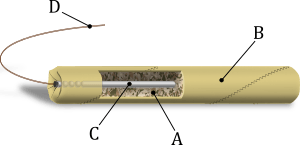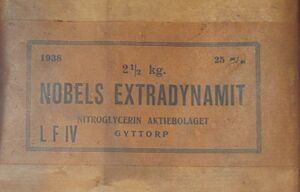Dynamite facts for kids

Dynamite is an explosive invented by Alfred Nobel. Its main explosive component is nitroglycerin. Nitroglycerin is very sensitive to movement. It explodes very easily, when moved. For this reason, it is absorbed into diatomaceous earth to make it less sensitive. Diatomaceous earth is a soft, sedimentary rock made of fossil diatoms. In dynamite, about one part of four is diatomaceous earth, the other three are nitroglycerin. A little sodium carbonate is added to stabilize the mixture.
Even though the diatomaceous earth takes away some of the dangers of nitroglycerin, there are still problems because the mixture is not stable in damp environments. Water causes the nitroglycerin to leak away. The nitroglycerin can build up, and explode unexpectedly.
For this reason, the formulation was changed. Instead of diatomaceous earth, gelignite was used to hold the nitroglycerin. Gelignite holds the nitroglycerin so that it cannot dissolve in water.
Today, dynamite is not much used. It has been replaced by explosives based on ammonium nitrate which use gelignite. These explosives cost less to make and are easier to handle than dynamite. However, works of fiction still show people using dynamite.
History
Dynamite was invented by Swedish chemist Alfred Nobel in 1866 and was the first safely manageable explosive stronger than black powder.
Alfred Nobel's father, Immanuel Nobel, was an industrialist, engineer, and inventor. He built bridges and buildings in Stockholm and founded Sweden's first rubber factory. His construction work inspired him to research new methods of blasting rock that were more effective than black powder. After some bad business deals in Sweden, in 1838 Immanuel moved his family to Saint Petersburg, where Alfred and his brothers were educated privately under Swedish and Russian tutors. At the age of 17, Alfred Nobel was sent abroad for two years; in the United States he met Swedish engineer John Ericsson and in France studied under famed chemist Théophile-Jules Pelouze and his pupil Ascanio Sobrero, who had first synthesized nitroglycerin in 1847. Pelouze cautioned Nobel against using nitroglycerine as a commercial explosive because of its great sensitivity to shock.
In 1857, Nobel filed the first of several hundred patents, mostly concerning air pressure, gas and fluid gauges, but remained fascinated with nitroglycerin's potential as an explosive. Nobel, along with his father and brother Emil, experimented with various combinations of nitroglycerin and black powder. Nobel came up with a way to safely detonate nitroglycerin by inventing the detonator, or blasting cap, that allowed a controlled explosion set off from a distance using a fuse. In 1863 Nobel performed his first successful detonation of pure nitroglycerin, using a blasting cap made of a copper percussion cap and mercury fulminate. In 1864, Alfred Nobel filed patents for both the blasting cap and his method of synthesizing nitroglycerin, using sulfuric acid, nitric acid and glycerin. On 3 September 1864, while experimenting with nitroglycerin, Emil and several others were killed in an explosion at the factory at Immanuel Nobel's estate at Heleneborg. After this, Alfred founded the company Nitroglycerin Aktiebolaget in Vinterviken to continue work in a more isolated area and the following year moved to Germany, where he founded another company, Dynamit Nobel.
Despite the invention of the blasting cap, the instability of nitroglycerin rendered it useless as a commercial explosive. To solve this problem, Nobel sought to combine it with another substance that would make it safe for transport and handling but would not reduce its effectiveness as an explosive. He tried combinations of cement, coal, and sawdust, but was unsuccessful. Finally, he tried diatomaceous earth, which is fossilized algae, that he brought from the Elbe River near his factory in Hamburg, which successfully stabilized the nitroglycerin into a portable explosive.
Nobel obtained patents for his inventions in England on 7 May 1867 and in Sweden on 19 October 1867. After its introduction, dynamite rapidly gained wide-scale use as a safe alternative to black powder and nitroglycerin. Nobel tightly controlled the patents, and unlicensed duplicating companies were quickly shut down. A few American businessmen got around the patent by using absorbents other than diatomaceous earth, such as resin.
Nobel originally sold dynamite as "Nobel's Blasting Powder" and later changed the name to dynamite, from the Ancient Greek word dýnamis (δύναμις), meaning "power".
Images for kids
-
Preparation of dynamite during the construction of the Douglas Dam, 1942.
See also
 In Spanish: Dinamita para niños
In Spanish: Dinamita para niños





